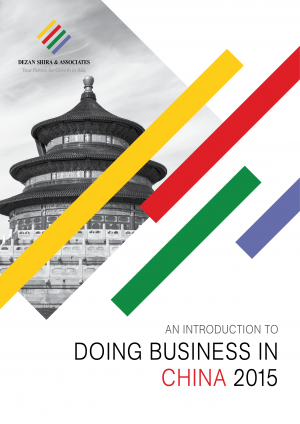China Market Watch: China’s FDI Inflows in 2015 and Recent Policy Changes to the Labor Market
China’s FDI Inflows and the Actual Use of FDI in 2015
On December 11, China’s Ministry of Commerce (MOFCOM) released the country’s latest foreign direct investment (FDI) inflows from January to November this year. A total number of 23,648 foreign-invested enterprises (FIEs) had been newly established (11 percent growth) in China by the end of November; 10,811 FIEs were set up in the Yangtze River Delta, accounting for 45.7 percent of the new FIEs in the whole country. Meanwhile, the actual use of FDI rose 7.9 percent to US$114.04 billion. It is noteworthy that the actual use of FDI in the service sector was US$69.58 billion, constituting over 60 percent of the total FDI in China. Among this, the actual use of FDI in the high-tech customer service sector rose 51.7 percent to US$7.23 billion – 85.9 percent growth in digital content and services, 55.1 percent in IT services and 29.7 percent growth in R&D services. In the manufacturing industry, a remarkable 366.3 percent growth rate occurred in the bio-pharmaceutical manufacturing sector.
The U.S., Japan, Taiwan, the EU and ASEAN nations remained the major investors in China. MOFCOM stated that growth in China’s FDI was expected to quicken to around four percent in 2015 from the previous year on government efforts to improve its investment environment.
Hong Kong and Mainland China Mutual Recognition of Funds
On December 18, China officially launched the first batch of authorized funds under the mutual recognition of funds (MRF) arrangement between Mainland China and Hong Kong. According to the arrangement, qualified China and Hong Kong funds may be offered directly to the public in each other’s market after obtaining authorization or approval under streamlined procedures. Initially there will be a quota of RMB 300 million (US$46.3 billion) in each direction, and funds are required to have been established for at least one year to take part in the scheme. Currently, seven funds have obtained the qualification (three Hong Kong and four China funds).
Starting July 1, 2015, regulators from both sides have started accepting applications under the mutual recognition of funds arrangement between the mainland and Hong Kong. Following the Agreement, the Chinese government released the “Caishui [2015] No 125,” which clarified tax implications on non-resident investors deriving income from a mutually recognized fund.
![]() RELATED: Payroll and Human Resource Services
RELATED: Payroll and Human Resource Services
China’s Labor Market Going through Changes
The Chinese government just approved the amended “Population and Family Planning Regulations,” which advocates that one couple should have two children and the new law will take effect on January 1, 2016. The new regulations stipulate that qualified couples shall be entitled to longer maternity/paternity leave or other benefits based on the local regulations. This move is estimated to affect 100 million couples in China and tackle the country’s aging population problem. Previously, couples nationwide are allowed to have a second child if either parent is an only child.
Earlier this year, China released a proposal to extend its mandatory retirement age, first change since the 1950s, in a move to ease social and fiscal pressures. As China’s labor market is undergoing changes, companies should keep updated with the relevant policy changes and adjust their HR policies accordingly.
|
Asia Briefing Ltd. is a subsidiary of Dezan Shira & Associates. Dezan Shira is a specialist foreign direct investment practice, providing corporate establishment, business advisory, tax advisory and compliance, accounting, payroll, due diligence and financial review services to multinationals investing in China, Hong Kong, India, Vietnam, Singapore and the rest of ASEAN. For further information, please email china@dezshira.com or visit www.dezshira.com. Stay up to date with the latest business and investment trends in Asia by subscribing to our complimentary update service featuring news, commentary and regulatory insight. |
![]()
 Human Resources and Payroll in China 2015
Human Resources and Payroll in China 2015
This edition of Human Resources and Payroll in China, updated for 2015, provides a firm understanding of China’s laws and regulations related to human resources and payroll management – essential information for foreign investors looking to establish or already running a foreign-invested entity in China, local managers, and HR professionals needing to explain complex points of China’s labor policies.
 An Introduction to Doing Business in China 2015
An Introduction to Doing Business in China 2015
Doing Business in China 2015 is designed to introduce the fundamentals of investing in China. Compiled by the professionals at Dezan Shira & Associates, this comprehensive guide is ideal not only for businesses looking to enter the Chinese market, but also for companies that already have a presence here and want to keep up-to-date with the most recent and relevant policy changes.
 Selling, Sourcing and E-Commerce in China 2016 (First Edition)
Selling, Sourcing and E-Commerce in China 2016 (First Edition)
This guide, produced in collaboration with the experts at Dezan Shira & Associates, provides a comprehensive analysis of all these aspects of commerce in China. It discusses how foreign companies can best go about sourcing products from China; how foreign retailers can set up operations on the ground to sell directly to the country’s massive consumer class; and finally details how foreign enterprises can access China’s lucrative yet ostensibly complex e-commerce market.
- Previous Article China Market Watch: China’s Commercial Healthcare Insurance Industry and Import/Export Business
- Next Article Andrew Polk’s 2016 China Economic Forecast – Weaker Growth and More Volatility to Come










